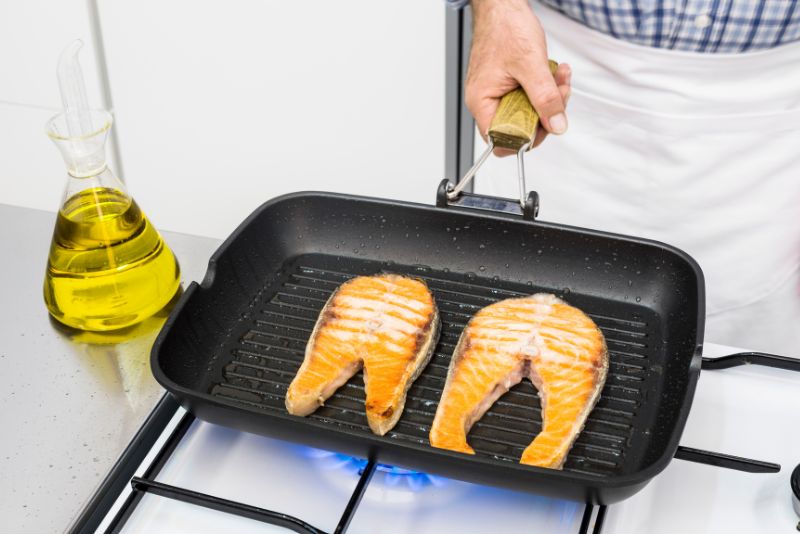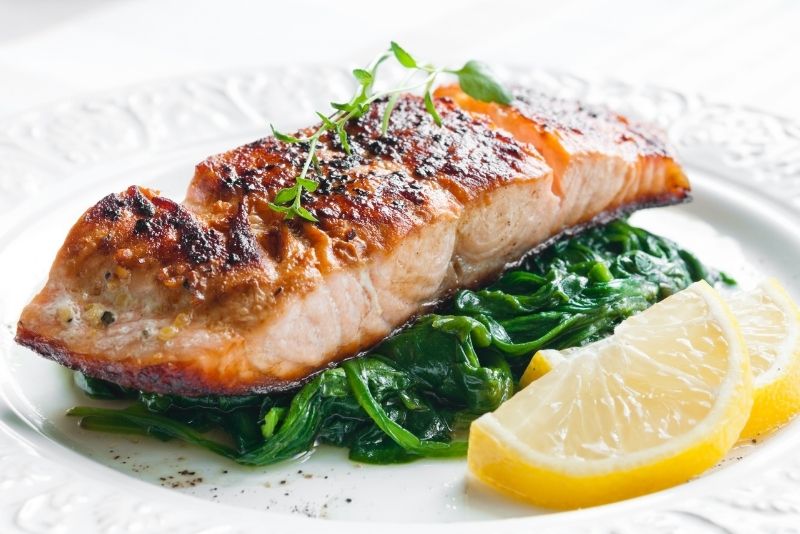Do you know how to tell if salmon is cooked? It’s a common question and one that can be difficult to answer.
Salmon is delicate and cooks quickly, so it’s important to know when it’s done cooking before serving.
If you don’t cook your salmon long enough, the fish will be raw in the middle and not safe for consumption. Overcooking your salmon can also lead to an unappetizing texture and flavor profile.
That’s why it is important sure to also read how to tell if salmon is bad so you know if the fish is safe to cook beforehand.
The good news is that there are several ways to tell if your salmon has been cooked properly. In this article, I’ll discuss a few helpful tips for determining when your salmon is cooked.
Table of Contents
How to Tell if Salmon Is Cooked?
You can determine when your salmon is cooked and ready to serve by pressing your finger into the flesh or by using a digital food thermometer to check if the internal temperature has reached 145 degrees Fahrenheit or more.
You can also check for signs of doneness by looking at the salmon itself. When cooked through, salmon should be opaque in color and flake easily with a fork.
1. The Touch-Press Method
One of the most simple ways to tell if salmon is cooked is by using the touch-press method, also known as the thumbprint test. To perform this test, press your finger into the flesh on the thickest part of the fillet.
If it feels soft or breaks apart, then your salmon is ready to be served. If it still feels firm, you should cook your salmon for a little longer and try again.
2. The Internal Temperature
Another helpful tactic for telling if your salmon is cooked is using the internal temperature of the fish. Be sure to use a meat thermometer when performing this method.
Your salmon is done cooking when your thermometer reads an internal temperature of 120°-125° F for medium-rare, 135° F for medium, and 145° F for well-done.
3. Salmon Color
Salmon flesh is typically a pink or orange color. When the fish cooks, it starts to turn whiter and opaque.
Yellowish and gray tones may occur when the fish is overcooked. Once again, be sure to use a meat thermometer to double-check that you do not overcook your salmon.
4. Texture
Salmon texture will change when it is cooked. Cooked salmon will flake easily and look opaque throughout the entire cut of fish, not just at the surface.
Raw salmon has a semi-translucent color and oily feel to it. If your fish still feels very firm, it’s best to cook it for a little longer and then check again.
The meat should be moist after cooking and if you touch it with your finger, there may be a small amount of buttery liquid but not much at all.
When picking up pieces of salmon in one hand, they should break off easily with little pressure.
5. Smell
As you are cooking your salmon, be sure to smell it to avoid overcooking. If the fish starts to boil, it will create a popping sound and release steam. When this happens, immediately turn down the heat to avoid overcooking.
Salmon should also have little or no smell before cooking. Fish should not smell “fishy”, but rather more like seawater.
Now that you know how to tell when salmon is cooked, you can enjoy this flavorful dish at home!
How To Cook Salmon?

Salmon can be either baked, grilled, pan-fried, roasted, smoked, or steamed. However, the most common ways to cook salmon are baking and grilling.
Before cooking a whole side of salmon, remove all of the scales using your fingers or a knife. Also, be sure to take out any innards by opening up the belly with a knife and pulling them out.
After cleaning the fish, dry it off with paper towels and lightly coat it with oil before cooking. Use a little more oil than you think is necessary, as this will help your fish not stick.
Cover your baking sheet or grill with aluminum foil and place the salmon on its skin side down for maximum effect.
If using an oven, set the temperature at 400 degrees Fahrenheit and cook for 10 minutes per one-inch thickness of fish.
If using a barbecue, cook skin side down for 4 to 5 minutes over high heat. Then turn it over and cook for 3 minutes.
Don’t be afraid to open the oven or grill to check on your fish after a few minutes of cooking time. This is where using extra oil comes into play, as it helps ensure that your salmon doesn’t stick to the pan.
After removing salmon from the heat source, allow it to cool for about 10 minutes. It will continue cooking internally while it does so, reaching an internal temperature of 145 degrees Fahrenheit which is medium-well.
Frequently Asked Questions
How does a cooked salmon taste?
Cooked salmon will have a rich, buttery flavor.
Raw fish will have a “gummy” or chewy texture when eaten alone or with no condiments added. Overcooked fish will be dry throughout the entire piece of fish, not just around the edges.
How to tell when salmon is done?
Each cooking method will yield slightly different results and have different ways to tell if salmon is done cooking. Salmon is commonly cooked in a variety of ways, including baked, grilled, pan-fried, roasted, smoked, and steamed.
So, if you are pan-frying your salmon, you’ll want to be sure that the fish is crispy on the outside and moist on the inside. But if you are grilling it, you’ll need to pay attention to whether or not the fish flakes easily with a fork.
How to know if salmon is cooked without a Thermometer?
The best way to tell if your salmon is cooked without a thermometer is by using the touch test. Gently press down on the top of the salmon fillet with your finger. If it flakes easily, it is cooked all the way through.
You can also check the color of the salmon to determine if it is cooked. The center of the salmon should be an opaque pink color. If it is still translucent, it needs to cook longer.
Lastly, you can smell the salmon to tell if it is done cooking. It should have a lightly cooked scent and not smell raw.
What’s the ideal temperature for cooked salmon?
According to FDA, the ideal temperature of cooked salmon is 145 degrees Fahrenheit, which you can check by using a digital food thermometer.
If you like medium-rare salmon, aim for a temperature of 120 to 130 degrees Fahrenheit.
What is the difference between rare, medium-rare, and well-done Salmon?
Rare salmon has a soft, translucent center with a pink exterior. It should be slightly firm to the touch.
Medium-rare salmon is pink throughout with a slightly firmer texture.
Well-done salmon is cooked through and has a flaky, opaque center.
Can you freeze cooked salmon?
You can freeze cooked salmon. Though, the biggest thing you have to think about is the quality of taste diminishing over time once it has been frozen.
Final Words
As you can see, there are many factors to consider when cooking salmon. By following these tips, you’ll be sure to impress your guests with a delicious and perfectly cooked meal.
